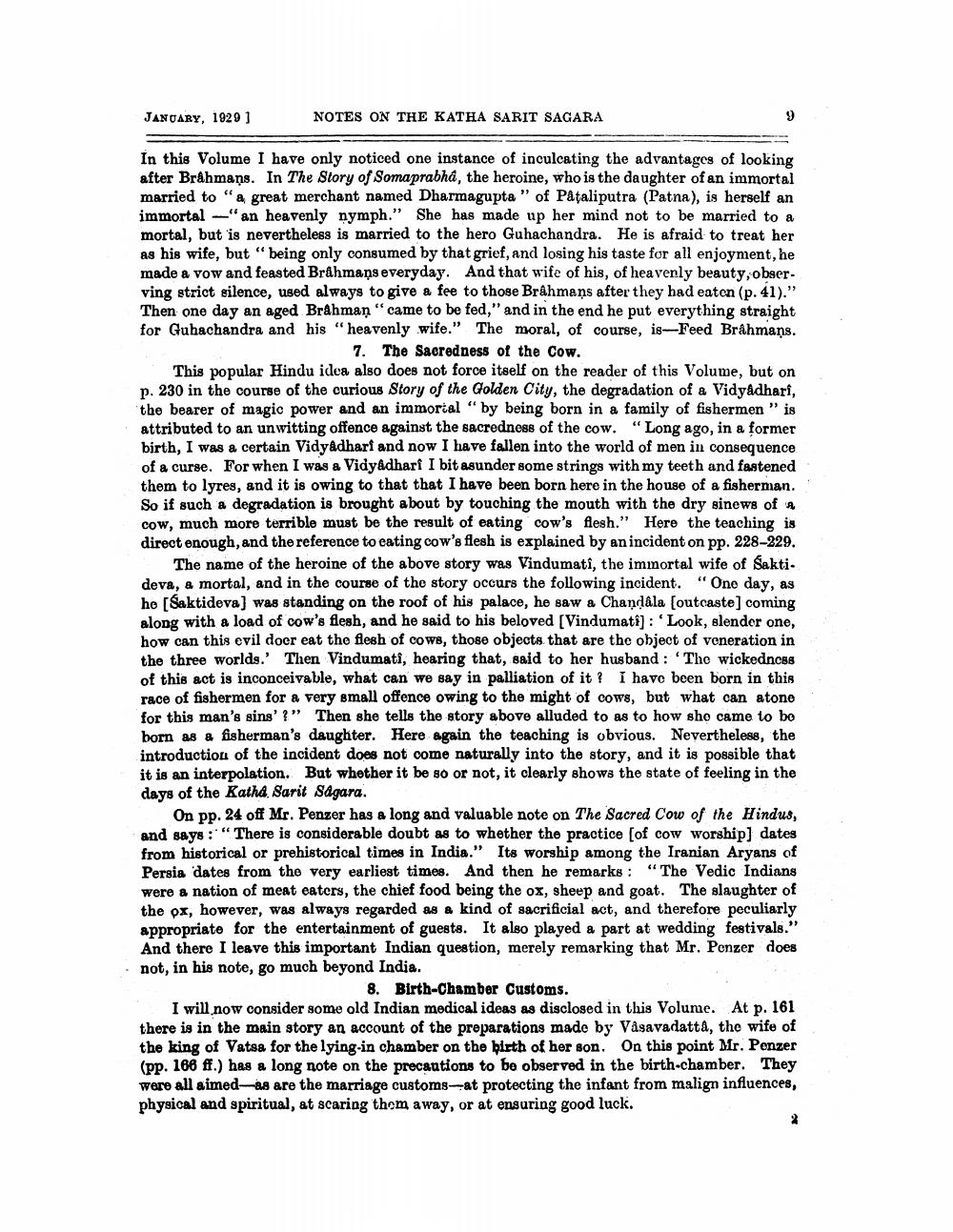________________
JANUARY, 1929 )
NOTES ON THE KATHA SARIT SAGARA
9
In this Volume I have only noticed one instance of inculcating the advantages of looking after Brahmans. In The Story of Somaprabha, the heroine, who is the daughter of an immortal married to "a great merchant named Dharmagupta ” of Påtaliputra (Patna), is herself an immortal -"an heavenly nymph." She has made up her mind not to be married to a mortal, but is nevertheless is married to the hero Guhachandra. He is afraid to treat her as his wife, but "being only consumed by that grief, and losing his taste for all enjoyment, he made a vow and feasted Bråhmaņs everyday. And that wife of his, of heavenly beauty, observing strict silence, used always to give a fee to those Brahmans after they had eaten (p. 41)." Then one day an aged Brahman "came to be fed," and in the end he put everything straight for Guhachandra and his "heavenly wife." The moral, of course, is-Feed Brâhmans.
7. The Sacredness of the Cow. This popular Hindu idea also does not force itself on the reader of this Volume, but on p. 230 in the course of the curious Story of the Golden City, the degradation of a Vidyadhari, the bearer of magic power and an immortal" by being born in a family of fishermen" is attributed to an unwitting offence against the sacredness of the cow. "Long ago, in a former birth, I was a certain Vidyadhari and now I have fallen into the world of men in consequence of a curse. For when I was a Vidyadhari I bit asunder some strings with my teeth and fastened them to lyres, and it is owing to that that I have been born here in the house of a fisherman. So if such a degradation is brought about by touching the mouth with the dry sinews of A cow, much more terrible must be the result of eating cow's flesh." Here the teaching is direct enough, and the reference to eating cow's flesh is explained by an incident on pp. 228-229.
The name of the heroine of the above story was Vindumati, the immortal wife of Sakti. deva, & mortal, and in the course of the story occurs the following incident. “One day, as he [Saktideva] was standing on the roof of his palace, he saw a Chandala (outcaste) coming along with a load of cow's flesh, and he said to his beloved (Vindumati] : 'Look, slender one, how can this evil door eat the flesh of cows, those objects that are the object of veneration in the three worlds.' Then Vindumati, hearing that, said to her husband : 'The wickednces of this act is inconceivable, what can we say in palliation of it? I have been born in this race of fishermen for a very small offence owing to the might of cows, but what can atone for this man's sing'?” Then she tells the story above alluded to as to how she came to bo born as a fisherman's daughter. Here again the teaching is obvious. Nevertheless, the introduction of the incident does not come naturally into the story, and it is possible that it is an interpolation. But whether it be 80 or not, it clearly shows the state of feeling in the days of the Kathd, Sarit Sagara.
On pp. 24 off Mr. Penzer has a long and valuable note on The Sacred Cow of the Hindus, and says: "There is considerable doubt as to whether the practice (of cow worship] dates from historical or prehistorical times in India." Its worship among the Iranian Aryans of Persia dates from the very earliest times. And then he remarks: "The Vedic Indians were a nation of meat eaters, the chief food being the ox, sheep and goat. The slaughter of the px, however, was always regarded as a kind of sacrificial act, and therefore peculiarly appropriate for the entertainment of guests. It also played a part at wedding festivals." And there I leave this important Indian question, merely remarking that Mr. Penzer does not, in his note, go much beyond India.
8. Birth-Chamber Customs. I will now consider some old Indian medical ideas as disclosed in this Volume. At p. 161 there is in the main story an account of the preparations made by Vasavadatta, the wife of the king of Vatsa for the lying-in chamber on the birth of her son. On this point Mr. Penzer (pp. 166 ff.) has a long note on the precautions to be observed in the birth-chamber. They were all aimed-as are the marriage customs-at protecting the infant from malign influences, physical and spiritual, at scaring them away, or at ensuring good luck.




